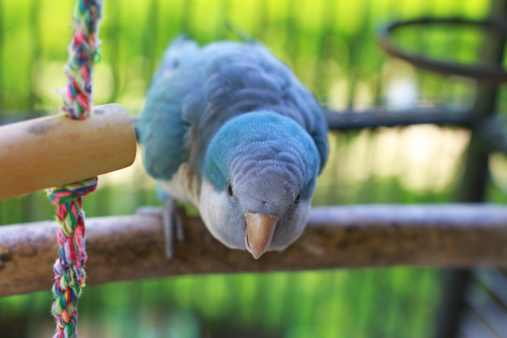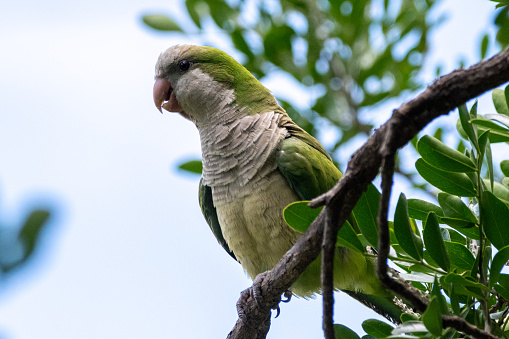To learn about Quaker parrot breeding read this interesting blog post! Quaker parrots are popular pet birds, known for their intelligence and playful nature. These birds are native to South America, but they can be found in homes all over the world.
If you’re thinking about breeding quaker parrots, there are a few things you need to know that are explained in this blog post and will be discussed as you read further.

Quakers reach sexual maturity at around one year of age, so it’s best to wait until they’re a bit older before starting the breeding process.
Quakers usually lay four to six eggs per clutch, and the incubation period is about 24 days. The female will do most of the incubating, but the male will help to keep her fed and watered. Once the eggs hatch, the parents will care for the young birds until they’re old enough to fend for themselves.
Quaker babies are very demanding, and they need to be fed a diet that is rich in calcium to prevent deficiencies. Breeding quaker parrots can be a rewarding experience, but it’s important to be prepared for the challenges that come along with it.
Quaker Parrot Breeding: Everything To Know

Quakers are native to South America, and their natural habitat is the subtropical forests. Quakers were introduced to North America in the 1800s, and they are now found throughout the United States. Quakers typically nest in trees, but they will also nest in artificial nesting boxes.
Quaker parrots are relatively easy to breed in captivity, and they make great pets. These birds are sexually mature at a young age, and they typically start breeding in early spring. Quaker babies are born blind and helpless, but they grow quickly and are ready to leave the nest in just six weeks.
If you are thinking about breeding quaker parrots, there are a few things you should know:
Quaker parrots are a popular pet bird, known for their ability to mimic human speech. These expressive little birds are also relatively easy to breed in captivity.
Quaker parrots reach sexual maturity at around 2 years of age. Breeding season typically occurs in early spring, but quaker parrots have been known to breed year-round in some cases. Both male and female Quakers play an active role in nesting, with the female usually laying 4-6 eggs per clutch.
Quaker babies hatch after about 24 days of incubation and typically fledge (leave the nest) at around 8-10 weeks of age. While quaker parrots are not difficult to breed, there are a few potential problems that new breeders should be aware of.
Egg binding, for example, can occur if the female does not have enough calcium in her diet. This can be prevented by feeding her a diet rich in calcium-rich foods such as leafy greens and seeds during the breeding season.
Artificial incubation is also sometimes necessary if the parents are unable to incubate the eggs successfully on their own. Overall, quaker parrots make excellent breeding birds and can provide hours of enjoyment for both experienced bird breeders and first-time pet owners alike.
Quaker parrots need a large cage or aviary, and they should have access to plenty of toys and perches. Quaker parrots should also be provided with a nest box and nesting materials such as wood shavings or straws.
Quaker babies typically fledge at about 10 weeks of age, but they should be kept with their parents until they are at least 12 weeks old.
A diet rich in calcium during the egg-laying process -either by adding calcium powder or supplements to their food- will help prevent any problems with egg binding, which can be common in quarters.
Breeding quaker parrots can be a rewarding experience; not only do these highly intelligent creatures make great pets, but they’re also very popular as aviary birds. With just a little bit of care and preparation, you can successfully breed these delightful creatures.
Common Problems Quaker Parrots Face During Breeding

If you’re thinking of breeding quaker parrots, there are a few things you should know. First, you’ll need to provide them with a nesting box and some appropriate nesting materials.
Quakers like to lay their eggs in secluded places, so the nest box should have its entrance. You’ll also need to make sure that your birds have access to calcium-rich foods during the breeding season.
Egg binding is a common problem in Quakers, so it’s important to keep an eye out for any signs of trouble. If you’re thinking of breeding quaker parrots, there’s no time like the present!
Quaker parrots are a popular pet bird, and many people enjoy breeding them. Quakers are sexually mature at a young age, and they start breeding in early spring. Quaker parrots typically lay four to six eggs per clutch, and the incubation period is about 24 days. Quakers are an active breed, and they are known for their playful personalities.
However, Quakers can also be aggressive, and they may become fond of one mate and aggressive towards others. Quakers are social birds, and they typically live in flocks in the wild.
Quakers generally mate for life, but if one mate dies, the other will often find another mate. Quakers generally live 15 to 20 years in captivity, but they can live up to 30 years in the wild which is their natural habitat.
Quaker parrots can be bred all year round, but the best time to breed them is mid-fall. Non-breeding quaker parrots should be fed a diet that is high in calcium-rich foods such as kale or spinach.
Breeding birds should be fed a diet that is higher in protein, and they should also be given extra calcium-rich foods such as hard-boiled eggs or crushed oyster shells.
Quaker parrots generally make good parents, but occasionally a female quaker may become egg-bound or have other health issues that prevent her from laying eggs or caring for her young.
If you are thinking about breeding quaker parrots, it is important to do your research so that you can provide your birds with the best possible care.
Conclusion
Breeding quaker parrots is not difficult, but there are a few things to keep in mind. Quakers reach sexual maturity at around one year of age, and they typically start breeding in early spring. The female will lay anywhere from two to eight eggs, with four being the average.
These social creatures do best when bred in pairs or small groups, so if you’re just starting it’s probably best to stick to one pair initially. Choose your breeding birds carefully; look for healthy specimens with good temperaments who haven’t shown any aggression or fearfulness.
To encourage successful nesting behavior, provide your Quakers with a spacious nest box along with plenty of nesting material like wood shavings – ideally before the female lays her first egg in mid-fall.








